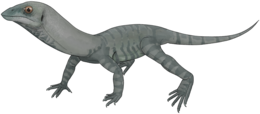Tanystropheidae
| Tanystropheidae Temporal range:Triassic,
| |||
|---|---|---|---|

| |||
| Skeletal reconstruction ofTanystropheus longobardicus | |||

| |||
| Life restoration ofLangobardisaurus | |||
| Scientific classification | |||
| Domain: | Eukaryota | ||
| Kingdom: | Animalia | ||
| Phylum: | Chordata | ||
| Class: | Reptilia | ||
| Clade: | Archosauromorpha | ||
| Clade: | †Tanysauria | ||
| Family: | †Tanystropheidae Gervais, 1858 | ||
| Genera[4] | |||
| |||
Tanystropheidaeis an extinctfamilyofarchosauromorphreptiles that lived throughout theTriassicPeriod, often considered to be "protorosaurs".They are characterized by their long, stiff necks formed from elongatedcervical vertebraewith very longcervical ribs.Members of the group include both terrestrial and aquatic forms. While some tanystropheids were small lizard-like animals, other tanystropheids such asTanystropheuswere large animals that had necks that were several meters long, longer than the rest of their bodies.
Tanystropheids are known fromEurope,Asia(Russia,China,andSaudi Arabia),North America[5]and probablySouth America(Brazil).[6]The presence of tanystropheids in Europe and China indicate that they lived along much of the coastline of theTethys Ocean.[7]However, species in western North America are found in terrestrial deposits, suggesting that as a group, tanystropheids were ecologically diverse.[5]
Relationships among tanystropheid species have been difficult to resolve because most specimens were flattened during fossilization and are preserved two-dimensionally. Three-dimensional fossils are known from Europe and North America.[5]
Phylogeny
[edit]In2021,a phylogenetic study was conducted by S. Spiekman, N. Fraser, and T. Scheyer in an attempt to clarify the systematics of "protorosaur"groups. A total of 16 individual trees were found using different character scoring methods and unstableOTUexclusions. The following cladogram shows the results of analysis 3A. In this analysis, ratio and ordered characters are treated as such, and 5 out of 40 OTUs (Macrocnemus obristi,Elessaurus gondwanoccidens,Tanytrachelos ahynis,Tanystropheus “conspicuus”,andRaibliania calligarisi) are pruned after the analysis to minimizepolytomies:[8]
| Archosauromorpha |
| ||||||||||||||||||||||||||||||
A later 2024 study grouped Tanystropheidae along withTrachelosauridaein the new cladeTanysauria.[9]
References
[edit]- ^Wang, W.; Spiekman, S. N. F.; Zhao, L.; Rieppel, O.; Scheyer, T. M.; Fraser, N. C.; Li, C. (2023). "A new long-necked archosauromorph from the Guanling Formation (Anisian, Middle Triassic) of southwestern China and its implications for neck evolution in tanystropheids".The Anatomical Record.doi:10.1002/ar.25216.PMID37029530.S2CID258028261.
- ^Lu, Y.-T.; Liu, J. (2023). "A new tanystropheid (Diapsida: Archosauromorpha) from the Middle Triassic of SW China and the biogeographical origin of Tanystropheidae".Journal of Systematic Palaeontology.21(1).Bibcode:2023JSPal..2150778L.doi:10.1080/14772019.2023.2250778.S2CID263634664.
- ^abAdam C. Pritchard; Hans-Dieter Sues (2019). "Postcranial remains ofTeraterpeton hrynewichorum(Reptilia: Archosauromorpha) and the mosaic evolution of the saurian postcranial skeleton ".Journal of Systematic Palaeontology.17(20): 1745–1765.Bibcode:2019JSPal..17.1745P.doi:10.1080/14772019.2018.1551249.S2CID91446492.
- ^Fossilworks
- ^abcPritchard, Adam C; et al. (2015). "Late Triassic tanystropheids (Reptilia, Archosauromorpha) from northern New Mexico (Petrified Forest Member, Chinle Formation) and the biogeography, functional morphology, and evolution of Tanystropheidae".Journal of Vertebrate Paleontology.35(2): e911186.Bibcode:2015JVPal..35E1186P.doi:10.1080/02724634.2014.911186.S2CID130089407.
- ^Tiane Macedo De Oliveira; Daniel Oliveira; Cesar L. Schultz; Leonardo Kerber; Felipe L. Pinheiro (2018)."Tanystropheid archosauromorphs in the Lower Triassic of Gondwana".Acta Palaeontologica Polonica.63(4): 713–723.doi:10.4202/app.00489.2018.
- ^Rieppel, O.; Jiang, D. Y.; Fraser, N. C.; Hao, W. C.; Motani, R.; Sun, Y. L.; Sun, Z. Y. (2010). "Tanystropheuscf.T. Longobardicusfrom the early Late Triassic of Guizhou Province, southwestern China ".Journal of Vertebrate Paleontology.30(4): 1082.Bibcode:2010JVPal..30.1082R.doi:10.1080/02724634.2010.483548.S2CID86315078.
- ^Spiekman, S. N. F.; Fraser, N. C.; Scheyer, T. M. (2021)."A new phylogenetic hypothesis of Tanystropheidae (Diapsida, Archosauromorpha) and other" protorosaurs ", and its implications for the early evolution of stem archosaurs".PeerJ.9:e11143.doi:10.7717/peerj.11143.PMC8101476.PMID33986981.
- ^Spiekman, Stephan N. F.; Ezcurra, Martín D.; Rytel, Adam; Wang, Wei; Mujal, Eudald; Buchwitz, Michael; Schoch, Rainer R. (2024-03-15)."A redescription ofTrachelosaurus fischerifrom the Buntsandstein (Middle Triassic) of Bernburg, Germany: the first EuropeanDinocephalosaurus-like marine reptile and its systematic implications for long-necked early archosauromorphs ".Swiss Journal of Palaeontology.143(1): 10.doi:10.1186/s13358-024-00309-6.ISSN1664-2384.



